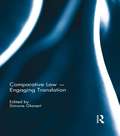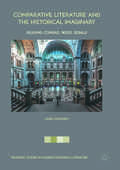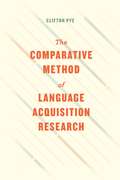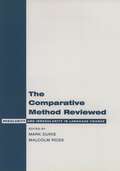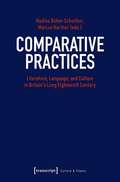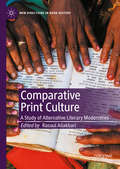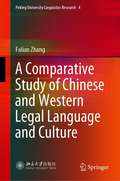- Table View
- List View
Comparative Law - Engaging Translation
by Simone GlanertIn an era marked by processes of economic, political and legal integration that are arguably unprecedented in their range and impact, the translation of law has assumed a significance which it would be hard to overstate. The following situations are typical. A French law school is teaching French law in the English language to foreign exchange students. Some US legal scholars are exploring the possibility of developing a generic or transnational constitutional law. German judges are referring to foreign law in a criminal case involving an honour killing committed in Germany with a view to ascertaining the relevance of religious prescriptions. European lawyers are actively working on the creation of a common private law to be translated into the 24 official languages of the European Union. Since 2004, the World Bank has been issuing reports ranking the attractiveness of different legal cultures for doing business. All these examples raise in one way or the other the matter of translation from a comparative legal perspective. However, in today’s globalised world where the need to communicate beyond borders arises constantly in different guises, many comparatists continue not to address the issue of translation. This edited collection of essays brings together leading scholars from various cultural and disciplinary backgrounds who draw on fields such as translation studies, linguistics, literary theory, history, philosophy or sociology with a view to promoting a heightened understanding of the complex translational implications pertaining to comparative law, understood both in its literal and metaphorical senses.
Comparative Law - Engaging Translation
by Simone GlanertIn an era marked by processes of economic, political and legal integration that are arguably unprecedented in their range and impact, the translation of law has assumed a significance which it would be hard to overstate. The following situations are typical. A French law school is teaching French law in the English language to foreign exchange students. Some US legal scholars are exploring the possibility of developing a generic or transnational constitutional law. German judges are referring to foreign law in a criminal case involving an honour killing committed in Germany with a view to ascertaining the relevance of religious prescriptions. European lawyers are actively working on the creation of a common private law to be translated into the 24 official languages of the European Union. Since 2004, the World Bank has been issuing reports ranking the attractiveness of different legal cultures for doing business. All these examples raise in one way or the other the matter of translation from a comparative legal perspective. However, in today’s globalised world where the need to communicate beyond borders arises constantly in different guises, many comparatists continue not to address the issue of translation. This edited collection of essays brings together leading scholars from various cultural and disciplinary backgrounds who draw on fields such as translation studies, linguistics, literary theory, history, philosophy or sociology with a view to promoting a heightened understanding of the complex translational implications pertaining to comparative law, understood both in its literal and metaphorical senses.
Comparative Literature (Routledge Revivals)
by Henry GiffordComparative Literature explores an 'area of interest' rather than a special discipline. The book begins with an account of the approaches that twentieth century writers took to literature by writers other than themselves. It discusses the common tone shared by those who subscribe to a national tradition, and considers what is meant by 'the mind of Europe'. It ponders the problems of translation, and discusses the nature of comparative study at university. Lastly, the special case of American literature is treated as pointing to the need for adjustment to a new stage in the world's culture. The criticial discussion of comparative studies provided in this book demonstrates the greater depth and vivacity that these studies can give to our ideas about literature.
Comparative Literature (Routledge Revivals)
by Henry GiffordComparative Literature explores an 'area of interest' rather than a special discipline. The book begins with an account of the approaches that twentieth century writers took to literature by writers other than themselves. It discusses the common tone shared by those who subscribe to a national tradition, and considers what is meant by 'the mind of Europe'. It ponders the problems of translation, and discusses the nature of comparative study at university. Lastly, the special case of American literature is treated as pointing to the need for adjustment to a new stage in the world's culture. The criticial discussion of comparative studies provided in this book demonstrates the greater depth and vivacity that these studies can give to our ideas about literature.
Comparative Literature and the Historical Imaginary: Reading Conrad, Weiss, Sebald
by Kaisa KaakinenThis book argues that increasingly transnational reading contexts of the twenty-first century place new pressures on fundamental questions about how we read literary fiction. Prompted by the stylistic strategies of three European émigré writers of the twentieth century — Conrad, Weiss and Sebald — it demonstrates the need to pose more differentiated questions about specific effects that occur when literary narratives meet a readership with a heterogeneous historical imaginary. In conversation with reception theory, trauma theory and transnational and postcolonial studies, the study shows how historical pressures in the twentieth and twenty-first centuries require comparative literature to address not only implied but also various unimplied reading positions that engage history in displaced yet material ways. This book opens new analytical paths for thinking about literary texts as media of historical imagination and conceiving relations between incommensurable historical events and contexts. Challenging overly global and overly local readings alike, the book presents a sophisticated contribution to discussions on how to reform the discipline of comparative literature in the twenty-first century.
Comparative Literature and the Historical Imaginary: Reading Conrad, Weiss, Sebald(PDF)
by Kaisa KaakinenThis book argues that increasingly transnational reading contexts of the twenty-first century place new pressures on fundamental questions about how we read literary fiction. Prompted by the stylistic strategies of three European émigré writers of the twentieth century — Conrad, Weiss and Sebald — it demonstrates the need to pose more differentiated questions about specific effects that occur when literary narratives meet a readership with a heterogeneous historical imaginary. In conversation with reception theory, trauma theory and transnational and postcolonial studies, the study shows how historical pressures in the twentieth and twenty-first centuries require comparative literature to address not only implied but also various unimplied reading positions that engage history in displaced yet material ways. This book opens new analytical paths for thinking about literary texts as media of historical imagination and conceiving relations between incommensurable historical events and contexts. Challenging overly global and overly local readings alike, the book presents a sophisticated contribution to discussions on how to reform the discipline of comparative literature in the twenty-first century.
Comparative Literature In Europe (PDF): Challenges And Perspectives
by Nikol Dziub Èdèrique Toudoire-SurlapierreThanks to its historical, theoretical, and methodological dimensions, this book is unique, both in Europe and in the USA. It brings together researchers from across Europe to explain how comparative literature works, both on an institutional and a technical level, in the country in which they work. The contributions also define the characteristics of European comparative literature on a continental level. From Austria to Ukraine, by way of Belgium, Estonia, Finland, France, Ireland, Lithuania, Luxembourg, Macedonia, Poland, Portugal, Romania, Slovakia, Spain, and Switzerland, the book offers an expansive panorama, placing great emphasis on usually "invisible" countries. Moreover, it relates both to the postcolonial and post-Soviet present and to the future of comparative literature; it is a handbook, but also a laboratory.
Comparative Literature: A Very Short Introduction (Very Short Introductions)
by Ben HutchinsonComparative Literature is both the past and the future of literary studies. Its history is intimately linked to the political upheavals of modernity: from colonial empire-building in the nineteenth century, via the Jewish diaspora of the twentieth century, to the postcolonial culture wars of the twenty-first century, attempts at 'comparison' have defined the international agenda of literature. But what is comparative literature? Ambitious readers looking to stretch themselves are usually intrigued by the concept, but uncertain of its implications. And rightly so, in many ways: even the professionals cannot agree on a single term, calling it comparative in English, compared in French, and comparing in German. The very term itself, when approached comparatively, opens up a Pandora's box of cultural differences. Yet this, in a nutshell, is the whole point of comparative literature. To look at literature comparatively is to realize just how much can be learned by looking over the horizon of one's own culture; it is to discover not only more about other literatures, but also about one's own; and it is to participate in the great utopian dream of understanding the way nations and languages interact. In an age that is paradoxically defined by migration and border crossing on the one hand, and by a retreat into monolingualism and monoculturalism on the other, the cross-cultural agenda of comparative literature has become increasingly central to the future of the Humanities. We are all, in fact, comparatists, constantly making connections across languages, cultures, and genres as we read. The question is whether we realise it. This Very Short Introduction tells the story of Comparative Literature as an agent of international relations, from the point of view both of scholarship and of cultural history more generally. Outlining the complex history and competing theories of comparative literature, Ben Hutchinson offers an accessible means of entry into a notoriously slippery subject, and shows how comparative literature can be like a Rorschach test, where people see in it what they want to see. Ultimately, Hutchinson places comparative literature at the very heart of literary criticism, for as George Steiner once noted, 'to read is to compare'. ABOUT THE SERIES: The Very Short Introductions series from Oxford University Press contains hundreds of titles in almost every subject area. These pocket-sized books are the perfect way to get ahead in a new subject quickly. Our expert authors combine facts, analysis, perspective, new ideas, and enthusiasm to make interesting and challenging topics highly readable.
Comparative Literature: A Very Short Introduction (Very Short Introductions)
by Ben HutchinsonComparative Literature is both the past and the future of literary studies. Its history is intimately linked to the political upheavals of modernity: from colonial empire-building in the nineteenth century, via the Jewish diaspora of the twentieth century, to the postcolonial culture wars of the twenty-first century, attempts at 'comparison' have defined the international agenda of literature. But what is comparative literature? Ambitious readers looking to stretch themselves are usually intrigued by the concept, but uncertain of its implications. And rightly so, in many ways: even the professionals cannot agree on a single term, calling it comparative in English, compared in French, and comparing in German. The very term itself, when approached comparatively, opens up a Pandora's box of cultural differences. Yet this, in a nutshell, is the whole point of comparative literature. To look at literature comparatively is to realize just how much can be learned by looking over the horizon of one's own culture; it is to discover not only more about other literatures, but also about one's own; and it is to participate in the great utopian dream of understanding the way nations and languages interact. In an age that is paradoxically defined by migration and border crossing on the one hand, and by a retreat into monolingualism and monoculturalism on the other, the cross-cultural agenda of comparative literature has become increasingly central to the future of the Humanities. We are all, in fact, comparatists, constantly making connections across languages, cultures, and genres as we read. The question is whether we realise it. This Very Short Introduction tells the story of Comparative Literature as an agent of international relations, from the point of view both of scholarship and of cultural history more generally. Outlining the complex history and competing theories of comparative literature, Ben Hutchinson offers an accessible means of entry into a notoriously slippery subject, and shows how comparative literature can be like a Rorschach test, where people see in it what they want to see. Ultimately, Hutchinson places comparative literature at the very heart of literary criticism, for as George Steiner once noted, 'to read is to compare'. ABOUT THE SERIES: The Very Short Introductions series from Oxford University Press contains hundreds of titles in almost every subject area. These pocket-sized books are the perfect way to get ahead in a new subject quickly. Our expert authors combine facts, analysis, perspective, new ideas, and enthusiasm to make interesting and challenging topics highly readable.
The Comparative Method of Language Acquisition Research
by Clifton PyeThe Mayan family of languages is ancient and unique. With their distinctive relational nouns, positionals, and complex grammatical voices, they are quite alien to English and have never been shown to be genetically related to other New World tongues. These qualities, Clifton Pye shows, afford a particular opportunity for linguistic insight. Both an overview of lessons Pye has gleaned from more than thirty years of studying how children learn Mayan languages as well as a strong case for a novel method of researching crosslinguistic language acquisition more broadly, this book demonstrates the value of a close, granular analysis of a small language lineage for untangling the complexities of first language acquisition. Pye here applies the comparative method to three Mayan languages—K’iche’, Mam, and Ch’ol—showing how differences in the use of verbs are connected to differences in the subject markers and pronouns used by children and adults. His holistic approach allows him to observe how small differences between the languages lead to significant differences in the structure of the children’s lexicon and grammar, and to learn why that is so. More than this, he expects that such careful scrutiny of related languages’ variable solutions to specific problems will yield new insights into how children acquire complex grammars. Studying such an array of related languages, he argues, is a necessary condition for understanding how any particular language is used; studying languages in isolation, comparing them only to one’s native tongue, is merely collecting linguistic curiosities.
The Comparative Method of Language Acquisition Research
by Clifton PyeThe Mayan family of languages is ancient and unique. With their distinctive relational nouns, positionals, and complex grammatical voices, they are quite alien to English and have never been shown to be genetically related to other New World tongues. These qualities, Clifton Pye shows, afford a particular opportunity for linguistic insight. Both an overview of lessons Pye has gleaned from more than thirty years of studying how children learn Mayan languages as well as a strong case for a novel method of researching crosslinguistic language acquisition more broadly, this book demonstrates the value of a close, granular analysis of a small language lineage for untangling the complexities of first language acquisition. Pye here applies the comparative method to three Mayan languages—K’iche’, Mam, and Ch’ol—showing how differences in the use of verbs are connected to differences in the subject markers and pronouns used by children and adults. His holistic approach allows him to observe how small differences between the languages lead to significant differences in the structure of the children’s lexicon and grammar, and to learn why that is so. More than this, he expects that such careful scrutiny of related languages’ variable solutions to specific problems will yield new insights into how children acquire complex grammars. Studying such an array of related languages, he argues, is a necessary condition for understanding how any particular language is used; studying languages in isolation, comparing them only to one’s native tongue, is merely collecting linguistic curiosities.
The Comparative Method of Language Acquisition Research
by Clifton PyeThe Mayan family of languages is ancient and unique. With their distinctive relational nouns, positionals, and complex grammatical voices, they are quite alien to English and have never been shown to be genetically related to other New World tongues. These qualities, Clifton Pye shows, afford a particular opportunity for linguistic insight. Both an overview of lessons Pye has gleaned from more than thirty years of studying how children learn Mayan languages as well as a strong case for a novel method of researching crosslinguistic language acquisition more broadly, this book demonstrates the value of a close, granular analysis of a small language lineage for untangling the complexities of first language acquisition. Pye here applies the comparative method to three Mayan languages—K’iche’, Mam, and Ch’ol—showing how differences in the use of verbs are connected to differences in the subject markers and pronouns used by children and adults. His holistic approach allows him to observe how small differences between the languages lead to significant differences in the structure of the children’s lexicon and grammar, and to learn why that is so. More than this, he expects that such careful scrutiny of related languages’ variable solutions to specific problems will yield new insights into how children acquire complex grammars. Studying such an array of related languages, he argues, is a necessary condition for understanding how any particular language is used; studying languages in isolation, comparing them only to one’s native tongue, is merely collecting linguistic curiosities.
The Comparative Method of Language Acquisition Research
by Clifton PyeThe Mayan family of languages is ancient and unique. With their distinctive relational nouns, positionals, and complex grammatical voices, they are quite alien to English and have never been shown to be genetically related to other New World tongues. These qualities, Clifton Pye shows, afford a particular opportunity for linguistic insight. Both an overview of lessons Pye has gleaned from more than thirty years of studying how children learn Mayan languages as well as a strong case for a novel method of researching crosslinguistic language acquisition more broadly, this book demonstrates the value of a close, granular analysis of a small language lineage for untangling the complexities of first language acquisition. Pye here applies the comparative method to three Mayan languages—K’iche’, Mam, and Ch’ol—showing how differences in the use of verbs are connected to differences in the subject markers and pronouns used by children and adults. His holistic approach allows him to observe how small differences between the languages lead to significant differences in the structure of the children’s lexicon and grammar, and to learn why that is so. More than this, he expects that such careful scrutiny of related languages’ variable solutions to specific problems will yield new insights into how children acquire complex grammars. Studying such an array of related languages, he argues, is a necessary condition for understanding how any particular language is used; studying languages in isolation, comparing them only to one’s native tongue, is merely collecting linguistic curiosities.
The Comparative Method of Language Acquisition Research
by Clifton PyeThe Mayan family of languages is ancient and unique. With their distinctive relational nouns, positionals, and complex grammatical voices, they are quite alien to English and have never been shown to be genetically related to other New World tongues. These qualities, Clifton Pye shows, afford a particular opportunity for linguistic insight. Both an overview of lessons Pye has gleaned from more than thirty years of studying how children learn Mayan languages as well as a strong case for a novel method of researching crosslinguistic language acquisition more broadly, this book demonstrates the value of a close, granular analysis of a small language lineage for untangling the complexities of first language acquisition. Pye here applies the comparative method to three Mayan languages—K’iche’, Mam, and Ch’ol—showing how differences in the use of verbs are connected to differences in the subject markers and pronouns used by children and adults. His holistic approach allows him to observe how small differences between the languages lead to significant differences in the structure of the children’s lexicon and grammar, and to learn why that is so. More than this, he expects that such careful scrutiny of related languages’ variable solutions to specific problems will yield new insights into how children acquire complex grammars. Studying such an array of related languages, he argues, is a necessary condition for understanding how any particular language is used; studying languages in isolation, comparing them only to one’s native tongue, is merely collecting linguistic curiosities.
The Comparative Method of Language Acquisition Research
by Clifton PyeThe Mayan family of languages is ancient and unique. With their distinctive relational nouns, positionals, and complex grammatical voices, they are quite alien to English and have never been shown to be genetically related to other New World tongues. These qualities, Clifton Pye shows, afford a particular opportunity for linguistic insight. Both an overview of lessons Pye has gleaned from more than thirty years of studying how children learn Mayan languages as well as a strong case for a novel method of researching crosslinguistic language acquisition more broadly, this book demonstrates the value of a close, granular analysis of a small language lineage for untangling the complexities of first language acquisition. Pye here applies the comparative method to three Mayan languages—K’iche’, Mam, and Ch’ol—showing how differences in the use of verbs are connected to differences in the subject markers and pronouns used by children and adults. His holistic approach allows him to observe how small differences between the languages lead to significant differences in the structure of the children’s lexicon and grammar, and to learn why that is so. More than this, he expects that such careful scrutiny of related languages’ variable solutions to specific problems will yield new insights into how children acquire complex grammars. Studying such an array of related languages, he argues, is a necessary condition for understanding how any particular language is used; studying languages in isolation, comparing them only to one’s native tongue, is merely collecting linguistic curiosities.
The Comparative Method Reviewed: Regularity And Irregularity In Language Change
by Mark Durie Malcolm RossHistorical reconstruction of languages relies on the comparative method, which itself depends on the notion of the regularity of change. The regularity of sound change is the famous Neogrammarian Hypothesis: "sound change takes place according to laws that admit no exception." The comparative method, however, is not restricted to the consideration of sound change, and neither is the assumption of regularity. Syntactic, morphological, and semantic change are all amenable in varying degrees, to comparative reconstruction, and each type of change is constrained in ways that enable the researcher to distinguish between regular and more irregular changes. This volume draws together studies by scholars engaged in historical reconstruction, all focussing on the subject of regularity and irregularity in the comparative method. A wide range of languages are represented, including Chinese, Germanic, and Austronesian.
The Comparative Method Reviewed: Regularity and Irregularity in Language Change
by Mark Durie Malcolm RossHistorical reconstruction of languages relies on the comparative method, which itself depends on the notion of the regularity of change. The regularity of sound change is the famous Neogrammarian Hypothesis: "sound change takes place according to laws that admit no exception." The comparative method, however, is not restricted to the consideration of sound change, and neither is the assumption of regularity. Syntactic, morphological, and semantic change are all amenable in varying degrees, to comparative reconstruction, and each type of change is constrained in ways that enable the researcher to distinguish between regular and more irregular changes. This volume draws together studies by scholars engaged in historical reconstruction, all focussing on the subject of regularity and irregularity in the comparative method. A wide range of languages are represented, including Chinese, Germanic, and Austronesian.
Comparative Modernism and Poetics of Time: Bergson, Tanpinar, Benjamin, Walser (New Comparisons in World Literature)
by Özen Nergis DolceroccaThis book explores the conceptualization of time in early twentieth-century literature and thought, based on a transnational and translational model of literary history, focusing on Turkish, French and German literary traditions. Each from different cultural backgrounds, these modernists provide a radical critique of modern time regimes, which calibrate time in singular temporal narratives. The book traces the philosophical strand of this critical chronometry from Henri Bergson’s theory of time, through Walter Benjamin’s ambivalence towards decay of tradition, and finally to A.H. Tanpınar and Robert Walser’s modernist fiction. Negotiating regionally marked concepts and topoi of temporality, it discusses networks of cultural circulations and maps a revised intersection of Turkish and Western European literary histories. It is an essential read for scholars and students of comparative and world literature, modernist studies, and cultural history.
Comparative North American Studies: Transnational Approaches to American and Canadian Literature and Culture
by Reingard M. NischikMerging selected approaches to Comparative North American Studies with detailed textual analyses, this book studies works of writers as diverse as Ernest Hemingway, Joyce Carol Oates, Tim O'Brien, and Margaret Atwood. Topics include comparative approaches to the North American modernist short story, narratives of the Canada-US border, and North American reviews of Atwood's novels.
Comparative Poetics: An Intercultural Essay on Theories of Literature (PDF)
by Earl Roy Miner"Comparative literature," Earl Miner writes, "clearly involves something more than comparing two great German poets, and something different from a Chinese studying French literature or a Russian studying Italian literature." But what would a true intercultural poetics be? This work proposes various ways to "study something other than what are, all things considered, the short and simple annals of one cultural parish at one historic moment." The first developed account of theories of literature from an intercultural standpoint, the book shows that an "originative" or "foundational" poetics develops in cultures with explicit poetics when critics define the nature and conditions of literature in terms of the then most esteemed genredrama, lyric, or narrative. Earl Miner demonstrates that these definitions and inferences from them constitute useful bases for comparative poetics.
Comparative Practices: Literature, Language, and Culture in Britain's Long Eighteenth Century (Edition Kulturwissenschaft #258)
by Nadine Böhm-Schnitker Marcus HartnerComparisons not only prove fundamental in the epistemological foundation of modernity (Foucault, Luhmann), but they fulfil a central function in social life and the production of art. Taking a cue from the Practice Turn in sociology, the contributors are investigating the role of comparative practices in the formation of eighteenth-century literature and culture. The book conceives of social practices of comparing as being entrenched in networks of circulation of bodies, artefacts, discourses, and ideas, and aims to investigate how such practices ordered and changed British literature and culture during the long eighteenth century.
Comparative Print Culture: A Study of Alternative Literary Modernities (New Directions in Book History)
by Rasoul AliakbariDrawing on comparative literary studies, postcolonial book history, and multiple, literary, and alternative modernities, this collection approaches the study of alternative literary modernities from the perspective ofcomparative print culture. The term comparative print culture designates a wide range of scholarly practices that discover, examine, document, and/or historicize various printed materials and their reproduction, circulation, and uses across genres, languages, media, and technologies, all within a comparative orientation. This book explores alternative literary modernities mostly by highlighting the distinct ways in which literary and cultural print modernities outside Europe evince the repurposing of European systems and cultures of print and further deconstruct their perceived universality.
A Comparative Study of Chinese and Western Legal Language and Culture (Peking University Linguistics Research #4)
by Falian ZhangThis book involves a variety of aspects and levels, including the diachronic and synchronic dimensions. Law profoundly affects our daily lives, but its language and culture can at times be nearly impossible to understand. As a comparative study of Chinese and Western legal language and legal culture, this book investigates the similarities and differences of both sides and identifies their respective advantages and disadvantages. Accordingly, it considers both social and cultural functions, and both theoretical and practical values.Firstly, the book addresses the differences, that is, the basic frameworks and disparities between the Chinese and Western legal languages and legal cultures. Secondly, it explores relevant changes over time, that is, the historical evolution and the basic driving forces that were at work before the Chinese and Western legal languages and cultures “met.” Lastly, the book elaborates on their fusion, that is, the conflicts and changes in Chinese and Western legal languages and cultures in China in the modern era, as well as the introduction, transplantation and transformation of Western legal culture.
A Comparative Study of Korean Literature: Literary Migration
by Sangjin ParkThis study in comparative literature reinterprets and reevaluates literary texts and socio-historical transitions, moving between the Korean, East Asian, and European contexts (and with particular reference to the reception of Dante Alighieri in the East). In the process, it reexamines the universality of literary values and reopens the questions of what literature is and what it can do. By close reading of texts, it aims to give exposure to Korean literature, in such a way as to attract more attention to the field of world literature and to focus on what kind of relationship they can form and what new horizon of literariness they can construct in the future. This work will help to put the geography of world literature on a more open and just basis, by showing the porous nature of literary migration and supplying the missing links in the current discourse on world literature.
A Comparative Study on the Translation of Detective Stories from a Systemic Functional Perspective (The M.A.K. Halliday Library Functional Linguistics Series)
by Yan WangThis book presents a corpus-based investigation of verbal projection in detective stories and their translations. Adopting both diachronic and synchronic approaches to compare two different Chinese translations, the book is one of the first attempts to conduct a comprehensive lexico-grammatical, logico-semantic and rhetorical, as well as contextual analysis of verbal projection in the Chinese context, especially the classical Chinese language context. Further, it studies the differences and similarities of different translators’ choices from both diachronic and synchronic perspectives. Given its scope, the book is relevant for all those interested in functional linguistics, translation studies and detective stories.
